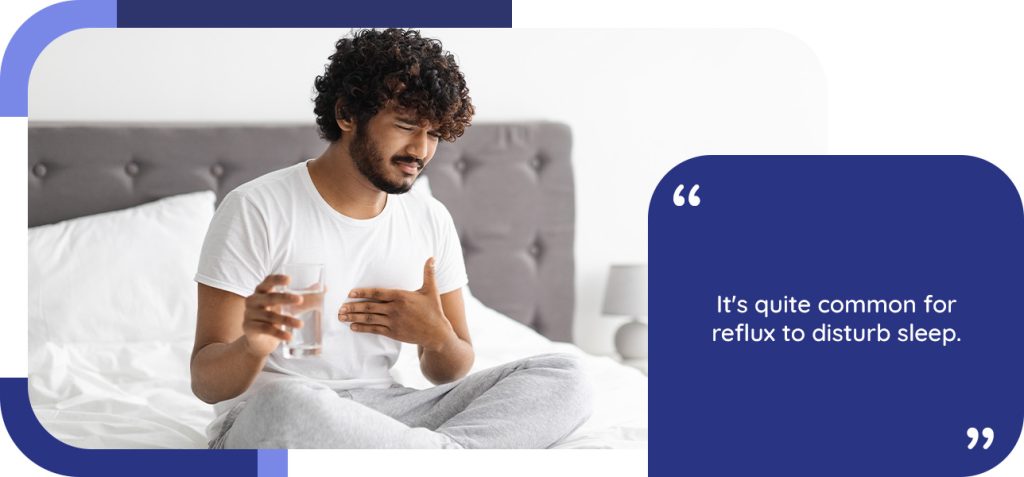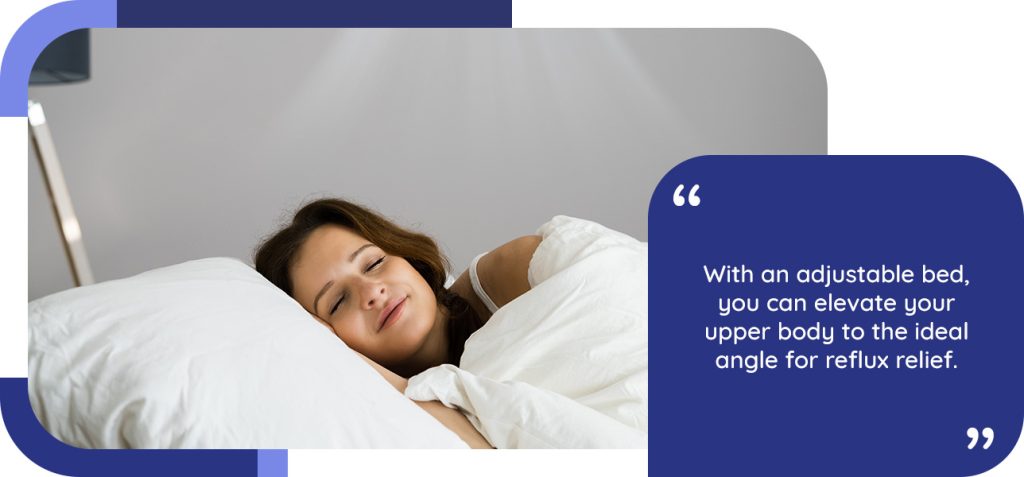Are adjustable beds good for acid reflux?

Acid reflux – also known as gastro-oesophageal reflux disease (GORD) when it’s frequent – occurs when stomach acid travels up into your oesophagus (food pipe), irritating the lining of your throat. This backflow of acid causes the characteristic heartburn – a burning pain in the chest, often after eating.
If you suffer from regular acid reflux, especially at night, you may be wondering if an adjustable bed could help. In this comprehensive guide, we’ll explain everything you need to know about acid reflux and sleep, and whether adjustable beds are good for relieving acid reflux symptoms.
Table of contents
- 1. What acid reflux (GORD) is and its symptoms
- 2. Why acid reflux can be worse at night
- 3. Sleeping position and night-time reflux
- 4. How adjustable beds help with acid reflux
- 5. Lifestyle changes to manage acid reflux
- 6. Medical treatments for acid reflux
- 7. Choosing an adjustable bed for acid reflux relief
- 8. Stop letting acid reflux steal your sleep
1. What is acid reflux (GORD)?
Acid reflux happens when acidic stomach contents leak up into the oesophagus. The harsh stomach acid irritates the delicate lining of your oesophagus and throat, leading to discomfort.
Heartburn is the most common symptom – a burning pain behind your breastbone (chest area), often rising towards the throat, typically felt after eating.
In the UK, frequent acid reflux is often diagnosed as gastro-oesophageal reflux disease (GORD), while you might also see the term GERD (gastroesophageal reflux disease) used elsewhere – they refer to the same condition.
Common symptoms of acid reflux:
- Heartburn: A painful burning sensation in the chest, usually after eating or when lying down. It can range from mild to very uncomfortable and is often worse when bending over or lying flat.
- Regurgitation: A sour or bitter-tasting acid backing up into your throat or mouth. You might feel food or liquid coming back up, leaving a bitter taste.
- Burping and bloating: Acid reflux can cause frequent belching or a feeling of fullness and bloating after meals.
- Sore throat or cough: The acid can irritate the throat, causing a persistent cough, hoarseness, or the feeling of a lump in the throat. These symptoms may be more noticeable in the morning after reflux at night.
- Difficulty swallowing (dysphagia): In some cases, prolonged reflux leads to inflammation that makes swallowing painful or difficult. This is a warning sign that needs medical attention.
Most people will experience mild heartburn at some point (for instance, after a large or spicy meal). However, around 1 in 10 adults suffers from heartburn daily or near daily, indicating chronic acid reflux that might require intervention.
What causes acid reflux?
Acid reflux occurs when the ring of muscle at the bottom of your oesophagus (the lower oesophageal sphincter) relaxes or weakens at the wrong time. This allows stomach acid to escape upward. There are several factors that can trigger or worsen this condition:
- Certain foods and drinks: Fatty or fried foods, spicy dishes, coffee, tea, fizzy drinks, citrus fruits, tomatoes, chocolate, and alcohol are common culprits that can trigger reflux symptoms. These can relax the sphincter or increase stomach acid production.
- Eating large meals or late at night: A very full stomach or lying down soon after eating can cause acid to press upward. Eating a heavy meal right before bedtime is a known recipe for nighttime heartburn.
- Being overweight or obese: Excess weight puts pressure on the abdomen, pushing up the stomach and encouraging acid to reflux. Losing weight if you’re overweight can significantly reduce this pressure and ease symptoms.
- Smoking: Smoking is known to irritate the digestive system and can weaken the oesophageal sphincter. It’s proven that smoking can make acid reflux worse, so quitting is highly recommended for reflux sufferers.
- Stress and anxiety: High stress levels don’t directly cause acid reflux, but they can exacerbate symptoms and perception of pain. Stress might also influence behaviours (like eating habits or smoking) that worsen reflux.
- Hiatus hernia: This is a condition where part of the stomach pushes up through the diaphragm into the chest cavity. It can make reflux more likely by disrupting the normal pressure barrier of the diaphragm.
Other factors like pregnancy (due to abdominal pressure and hormonal changes) and certain medications (e.g. some painkillers or anti-inflammatories) can also contribute to acid reflux.
2. Why acid reflux can be worse at night
Many people notice that their heartburn and reflux symptoms are especially bad at night or when lying down. In fact, it’s quite common for reflux to disturb sleep – you might wake up with burning pain or a sour taste in your mouth.
There are several reasons why night-time acid refluxis a problem:
- Gravity and position: When you’re upright during the day, gravity helps keep stomach acid down. Once you lie flat in bed, gravity is no longer preventing acid from refluxing into your oesophagus. This makes it easier for acid to escape upward, especially if you have a weak sphincter. People often experience more intense heartburn when lying down for this reason.
- Swallowing and saliva: During sleep, you swallow less frequently and produce less saliva. Swallowing helps clear acid from the oesophagus, and saliva can neutralise some acid. At night, these natural defences are reduced, so acid that creeps up can linger longer in your oesophagus, causing irritation.
- Late-night eating: If you eat dinner very late or have a bedtime snack, you’re more likely to have reflux at night. Lying down on a full stomach makes it easier for acid to press upward.
- Sleep apnoea and snoring: There is some correlation between obstructive sleep apnoea (pauses in breathing during sleep) and acid reflux. The strain of apnoea or heavy snoring might trigger or worsen reflux episodes at night.

Reflux symptoms can disrupt sleep quality. Beyond the discomfort of heartburn, acid reflux at night can cause coughing or choking sensations that wake you up. You might find yourself propping up pillows or needing to sip water during the night.
Over time, poorly managed nocturnal reflux can lead to chronic sore throat, cough, or even respiratory issues like aspiration pneumonia in severe cases.
However, by adjusting your sleeping position and bed setup, you can significantly reduce night-time reflux.
3. Sleeping position and night-time reflux
Since lying flat is a major contributor to night-time reflux, sleeping position makes a huge difference. Doctors and health experts have a few key recommendations to minimise reflux while you sleep:
Elevate the head of your bed
Raising the head end of your bed by roughly 15–20 cm (6–8 inches) is often recommended to harness gravity in your favour. By sleeping on a slight incline (with your head and chest higher than your stomach), it becomes harder for stomach acid to travel upward.
You can achieve this by:
- placing sturdy blocks or risers under the legs at the head of the bed
- using a foam wedge under the mattress.
Simply adding extra pillows under your head is not as effective, and can even worsen reflux by crimping your stomach area. Piling pillows tends to prop up only your head and neck, often forcing you into a hunched posture that increases abdominal pressure – exactly what we want to avoid. The goal is to elevate your upper body from the waist up, maintaining a straight, inclined alignment.
Sleep on your left side
Your sleeping side matters. Studies and clinical advice have found that sleeping on your left side is better for acid reflux than sleeping on your right side. The anatomy of your stomach is such that when you lie on your left side, the stomach is positioned below the oesophagus, making reflux less likely.
Left-side sleeping also helps gastric gases escape more easily, potentially reducing pressure. In contrast, lying on your right side can encourage acid to flow up into the oesophagus.For the same reason, sleeping flat on your back can be problematic for reflux, especially if you’re prone to snoring or sleep apnoea.
Avoid abdominal pressure
How you position yourself and what you wear to bed can affect reflux. Tight clothing or belts around the waist are a no-go – wear loose, comfortable pyjamas that don’t squeeze your middle. If you use an adjustable bed or recliner, avoid bending sharply at the waist. You want a gentle incline, not a harsh bend that crunches your stomach.
By combining an elevated upper body with left-side sleeping, you create the optimal scenario to reduce night-time acid reflux. You’ll have gravity helping you and your stomach positioned lower than your oesophagus. Many people report significantly fewer reflux episodes and better sleep after making these adjustments.
However, using bed blocks or wedges isn’t always convenient – and that’s where adjustable beds come into play.
4. How adjustable beds help with acid reflux
Investing in an adjustable bed is one of the simplest ways to consistently sleep on an incline, which is a doctor-recommended strategy for combating nocturnal reflux.
An adjustable bed is a bed base that can be electrically adjusted to different angles, allowing you to raise the head (and often the foot) of the bed to your liking. Here’s how an adjustable bed can help if you suffer from acid reflux:
Effortless elevation
With an adjustable bed, you can elevate your upper body to the ideal angle for reflux relief without fuss. No need for precarious stacks of pillows or blocks under the frame – you simply use a remote control to lift the head section of the bed.
Experts recommend elevating by around 6–8 inches, and an adjustable bed makes it easy to find the exact height that gives you relief. Because the whole upper platform inclines, it keeps your torso straight and supported as you sleep, maintaining good posture while preventing acid from rising.
Prevents pillow problems
As mentioned, piling pillows isn’t a great solution – you might slide off them, or they might bend you in a way that puts pressure on your stomach (making reflux worse). An adjustable bed eliminates this issue. You can sleep comfortably on your back or side on a flat mattress surface that’s simply tilted upward. Your neck and spine stay aligned, and you won’t wake up with a cricked neck or numb arms that sometimes result from an uncomfortable pillow position or sleeping on a mountain of pillows.
Customised comfort
Everyone’s reflux and comfort needs are a bit different. One of the advantages of an adjustable bed is that you can fine-tune the angle to what feels best for you. Some nights you may only need a slight elevation; other nights (say after a heavier meal) you might benefit from a steeper incline. You’re in control and can adjust the bed at any time during the night.
With quality adjustable beds, the movement is smooth and quiet, so if you do need to change position at 2 a.m., it won’t wake your partner.
Additional benefits
Beyond acid reflux, sleeping with your upper body elevated can help with other conditions, like snoring or sleep apnoea (by keeping airways more open) and orthopaedic issues (by relieving pressure on the back). Adjustable beds often allow you to elevate your legs as well, which can improve circulation and ease swelling or pain in the lower limbs.
Adjustable beds vs. other elevation methods
To truly appreciate an adjustable bed’s value, let’s quickly compare the alternatives for achieving an elevated sleep position:
- Bed risers or blocks: Placing blocks under the bed frame is effective, but it’s a bit of a crude solution. The bed is tilted all night (which some people find makes them slowly slide down). Also, it’s not easy to adjust nightly – the incline is fixed unless you remove the blocks. In contrast, an adjustable bed lets you elevate or flatten the bed at will with no physical effort.
- Wedge pillow: A wedge pillow is a triangular foam pillow you place on the mattress to incline your upper body. These can help, but many people find them uncomfortable or too rigid. You might struggle to find a good sleeping position on a wedge, and you’re limited to that one angle. Some also complain of sliding down the wedge during the night.
5. Lifestyle changes to manage acid reflux
While an adjustable bed can help with symptoms, it’s most effective when combined with healthy lifestyle changes to tackle the root causes of acid reflux. If you experience frequent heartburn or GORD, consider the following self-care tips:
Watch what you eat and drink
Certain foods trigger reflux in many people. Try to avoid or limit:
- spicy, fatty, or fried foods
- chocolate
- coffee
- fizzy drinks
- citrus
- tomatoes, garlic, and onions – especially in the afternoon or evening.
These items can either relax the oesophageal sphincter or increase acid production. Also be mindful of large amounts of peppermint, which can relax the sphincter. If you’re not sure which foods affect you, keep a food diary to track what you eat and any reflux symptoms that follow.
Eat smaller, frequent meals
Instead of three big meals, try having smaller portions more frequently. Overfilling your stomach makes reflux more likely. By eating moderate portions, you reduce pressure on that sphincter. Also, eat slowly and chew thoroughly. Rushing through a meal or eating on the go can provoke indigestion.
Timing is key – avoid late meals
Give yourself at least three hours between your last meal and bedtime. This allows time for food to move out of your stomach before you lie down. If you do need a later snack, make it something light and non-spicy, and don’t lie down immediately after eating.

Maintain a healthy weight
If you’re overweight, even a modest weight loss can improve reflux. Carrying extra weight around your midsection puts added pressure on your stomach, encouraging acid to reflux upward. By losing weight through a healthy diet and exercise, you literally “take the weight off” your stomach and oesophagus.
Stop smoking
Smoking aggravates acid reflux. The chemicals in cigarette smoke can relax the lower oesophageal sphincter, and smoking also increases stomach acidity while reducing saliva (which normally protects against acid). Smoking cessation often leads to noticeable improvements in digestive comfort.
Reduce alcohol and caffeine
Alcohol can irritate your stomach lining and relax the sphincter muscle – not a good combination for reflux. Try to moderate your intake and avoid heavy drinking, especially in the evening.
Similarly, caffeine can provoke heartburn in some people. You don’t have to necessarily cut caffeine completely if it doesn’t bother you, but if you suspect it’s contributing, switch to decaf or limit consumption.
Wear loose clothing
Tight belts, waistbands, or shapewear can squeeze your midsection and push acid upward. Opt for comfortable, looser clothing especially after meals and when sleeping.
Manage stress
Stress and anxiety can make reflux symptoms feel worse. When you’re stressed, digestion may slow down and you may produce more stomach acid. Finding ways to relax – whether through exercise, meditation, deep-breathing exercises, yoga, or even gentle hobbies – can help improve your overall digestive function.
6. Medical treatments for acid reflux
If you’ve adjusted your habits and sleeping position but still suffer from frequent acid reflux, it may be time to consider medical treatment. There are effective over-the-counter and prescription medicines that can control acid and give relief. Always consult with a healthcare professional for persistent symptoms, but here’s an overview of common treatments:
Antacids
These are fast-acting medicines that neutralise stomach acid. They come as chewable tablets or liquids.
Antacids provide quick, short-term relief by buffering the acid – for example, if you have heartburn after a meal, an antacid can calm the burn within minutes. They are very handy for occasional symptoms. However, the effect doesn’t last long, so they’re not a standalone solution for chronic GORD.
Alginates
Often combined with antacids in products like Gaviscon, alginates form a protective layer that floats on top of your stomach contents. This barrier helps prevent acid from refluxing into the oesophagus, especially when you’re lying down. Taking an alginate after meals and at bedtime can reduce night-time reflux symptoms.
H₂ blockers
Histamine-2 receptor antagonists (like famotidine) reduce acid production in the stomach. They’re available in lower doses over the counter and higher doses by prescription. H₂ blockers don’t act as quickly as antacids, but their effects last longer. Taking an H₂ blocker before bed can help prevent night-time acid production.
Proton Pump Inhibitors (PPIs)
PPIs (such as omeprazole, lansoprazole, esomeprazole, pantoprazole, etc.) are the most potent acid-suppressing medications. They work by blocking the mechanism in stomach lining cells that pumps acid into the stomach. PPIs are usually taken once daily (before breakfast) or twice daily for stubborn cases. They can take a few days of regular use to reach full effect, but they are very effective at healing inflammation and ulcers caused by acid. PPIs are considered the gold-standard treatment for frequent GORD.
When to see a doctor
If you have mild heartburn occasionally, you can usually manage it with the self-care steps and OTC medicines above. However, it’s important to consult a doctor if:
- You have heartburn or acid reflux more than two times a week or it’s affecting your daily life despite lifestyle changes.
- You’ve had heartburn most days for 3 weeks or more – even if it’s mild.
- You experience difficulty or pain when swallowing (food getting stuck).
- You have unintentional weight loss, frequent vomiting, or vomit that looks like coffee grounds/blood.
- Your reflux is causing respiratory issues (chronic cough, wheezing, or asthma-like symptoms).
A GP can evaluate your symptoms and may prescribe stronger medication or refer you for tests. One common test is an endoscopy, where a thin flexible camera is passed down your throat (under sedation) to look at your oesophagus and stomach.
7. Choosing an adjustable bed for acid reflux relief
If you’re considering improving your sleep and reducing night-time acid reflux by getting an adjustable bed, you’re making a wise choice. Adjustable beds come in various models and have different features, so here are a few tips to help you find the right one:
Ensure sufficient incline
For acid reflux, the main feature you need is a bed that elevates the head enough (around 6–8 inches or more). All electric adjustable beds will have a head incline function, but check the range of angles. You should be able to elevate to at least 30 degrees.
All Adjustamatic adjustable beds, for instance, are designed to allow comfortable elevation for medical benefits like reflux relief.
Comfort and support
Look for a bed that, in addition to being adjustable, has a comfortable mattress that supports you well when in a raised position. Memory foam or hybrid mattresses often work great on adjustable bases because they flex easily and distribute pressure evenly.
Adjustamatic offers specialised orthopaedic mattresses that pair with our adjustable bases to ensure you don’t feel any gap or uncomfortable bend when the bed is inclined.
Dual adjustability (for couples)
If you share a bed with a partner who doesn’t need their side elevated (or who perhaps needs a different sleep position), consider a dual adjustable bed. This typically means two single mattresses side by side on separately controlled bases. This way, one of you can sleep flat while the other elevates, without disturbing each other.
Adjustamatic’s dual size adjustable beds are a popular solution for couples with different needs.
Extra features
Modern adjustable beds can come with various quality-of-life features – massage functions, under-bed lighting, USB ports, wireless remote controls, memory settings to save your favourite position, and more.
While these aren’t necessary for reflux relief, they can enhance your overall sleep experience. When choosing, think about which features you’ll use and enjoy.
Ease of use and appearance
Make sure the controls are user-friendly (most are as simple as up/down buttons). Also, remember an adjustable bed doesn’t have to look like a “hospital bed”.
Adjustamatic adjustable beds are designed to look like elegant domestic beds, available in various fabrics and styles that blend with your bedroom decor.

8. Stop letting acid reflux steal your sleep
If you’re tired of nights disrupted by heartburn and burning sensations, it’s time to consider a solution that works with your body’s natural healing processes. You’ve learned how elevation can transform your sleep experience – now discover how Adjustamatic’s precision-engineered beds can make that relief a reality every single night.
The Adjustamatic approach to acid reflux relief
When you buy an adjustable bed from Adjustamatic, you’re also choosing a partner in better health.
For decades, we’ve been dedicated to British manufacturing excellence. Our adjustable beds are built to exacting standards, allowing us to offer an impressive 15-year guarantee on our adjustable mechanisms – a testament to their durability and your long-term peace of mind.
Here’s what sets our approach apart for acid reflux sufferers:
- Medically-informed design:At the touch of a button, our adjustable beds achieve the precise 6-8 inch elevation recommended by gastroenterologists, but with the comfort and support your body needs for restorative sleep. Unlike makeshift pillow solutions that can worsen symptoms, our beds maintain proper spinal alignment while keeping acid where it belongs.
- Therapeutic enhancement beyond elevation: Many of our models feature the NHC Cyclo-Therapy® massage system, which can help relax digestive muscles and reduce the stress that often exacerbates reflux symptoms. Combined with our Zero Gravity positioning, this creates an optimal environment for digestive comfort and healing sleep.
- Built for lasting relief: Handcrafted in our UK workshop with decades of engineering expertise, every Adjustamatic bed comes with our comprehensive 15-year guarantee on mechanisms. As a long-term investment in your health, our beds are built to provide consistent relief night after night.
- Personalised comfort solutions: Whether you need a single bed for individual relief or a dual-control system that lets your partner sleep flat while you stay elevated, we craft each bed to your specific requirements. Choose from our range of therapeutic adjustable mattresses and stylish finishes to create a sleep sanctuary that supports both your health and your home’s aesthetic.
Ready to reclaim peaceful nights?
Don’t spend another night battling acid reflux. Our sleep wellness specialists understand the connection between proper positioning and digestive health, and they’re ready to help you find your path to comfortable, reflux-free sleep.
Experience the relief firsthand: Book a complimentary in-home demonstration where you can test the exact elevation and comfort features that work best for your acid reflux, all in your own bedroom environment.
Call us today on 0800 689 9823 (lines open 9am-5pm Monday to Friday) or send us a messageto request your free consultation. If you qualify for a medical condition, we can also guide you through VAT exemption options.
Transform your nights from painful to peaceful – discover how Adjustamatic can help you sleep soundly again.


